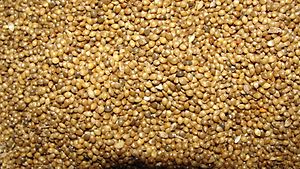Panicum sumatrense facts for kids
Quick facts for kids Panicum sumatrense |
|
|---|---|
 |
|
| Conservation status | |
| Scientific classification | |
| Genus: |
Panicum
|
| Species: |
sumatrense
|
| Synonyms | |
|
Panicum miliare auct. non Lam. |
|
Panicum sumatrense, known as little millet, is a type of grain that belongs to the grass family, just like wheat or rice. It's a very old crop, especially important in parts of Asia. People grow it for its small, round grains, which are used to make food.
Contents
What Little Millet Looks Like
Little millet is a plant that grows every year. It can stand straight up or have bent stems, reaching a height of about 30 centimeters (about 1 foot) to 1 meter (about 3 feet). Its leaves are long and thin. Sometimes, the leaves have tiny hairs.
The plant produces flower clusters called panicles. These panicles are usually 4 to 15 centimeters (about 1.5 to 6 inches) long. The grains themselves are small, round, and smooth, measuring about 1.8 to 1.9 millimeters long.
Different Kinds of Little Millet
Scientists have found two main types, or subspecies, of Panicum sumatrense:
- Panicum sumatrense subsp. psilopodium
- Panicum sumatrense subsp. sumatrense
Where Little Millet Grows
Little millet is found in many parts of Asia. You can find it in cooler areas like the Caucasus region and China. It also grows in warmer, tropical parts of the continent, including India, Indochina, and Malaysia.
This plant is quite tough! It can grow well even when there's not much water (drought) or when there's too much water (waterlogging). It can also be grown in high places, up to 2,000 meters (about 6,500 feet) above sea level.
Nutritional Value
Little millet is a healthy grain that provides good nutrition. Here's what you can find in it:
| Nutritional value per 100 g (3.5 oz) | |
|---|---|
| Energy | 341 kcal (1,430 kJ) |
|
67.0 g
|
|
| Dietary fiber | 7.6 g |
|
4.7 g
|
|
|
Protein
|
7.7 g
|
| Minerals | Quantity
%DV†
|
| Calcium |
2%
17.0 mg |
| Iron |
72%
9.3 mg |
| Phosphorus |
31%
220.0 mg |
| †Percentages estimated using US recommendations for adults. | |
Common Names for Little Millet
This grain has many different names depending on the language spoken in various regions:
- Hindi: Kutki, Shavan
- Bengali: Sama
- Tamil: Samai
- Gujarati: Gajro, Kuri
- Telugu: Samalu (సామలు)
- Marathi: Sava, Halvi, Vari
- Oriya: Suan
- Kannada: Saame (ಸಾಮೆ)
- Malayalam: Chama (ചാമ)
How Little Millet is Grown
Most little millet is grown in central India. Farmers often plant the seeds using a special machine called a seed drill. This machine helps plant the seeds evenly in the ground. If needed, it can also be planted by hand.
Besides being a food crop, the green plant can also be used to feed farm animals like cattle. The dried stems, called straw, can even be mixed with clay or cement and used to build things!
Farmers can usually harvest between 230 to 900 kilograms of millet from one hectare of land.
Pests That Affect Little Millet
Like many crops, little millet can be bothered by different kinds of pests. These are insects that can damage the plant.
Some common insect pests include:
- Shoot flies: These tiny flies lay eggs on the plant, and their larvae (young insects) can damage the shoots.
- Armyworms: These are caterpillars that can eat the leaves and other parts of the plant.
- Leaf feeders: This group includes different types of caterpillars and beetles that munch on the leaves.
- Grasshoppers: These jumping insects can also eat the leaves.
- Earhead feeders: These bugs feed on the developing grains in the plant's "ear" or seed head.
- Stalk borers: These pests tunnel into the plant's stalks.
Little Millet in History
Little millet has been an important food for a very long time. Archaeologists have found many little millet grains at ancient sites of the Indus Valley Civilisation, like Harappa and Farmana.
At Harappa, over 10,000 grains of little millet were discovered! This shows that little millet was a major crop there around 2600 BC, making up about 5% of all the grains grown at that time.
How to Prepare Little Millet
Little millet is usually cooked in a similar way to rice. You can boil it and serve it as a side dish. Sometimes, the millet grains are also ground into flour and used for baking, perhaps to make flatbreads or other baked goods. The grain contains about 7.7% protein, making it a good source of this important nutrient.


